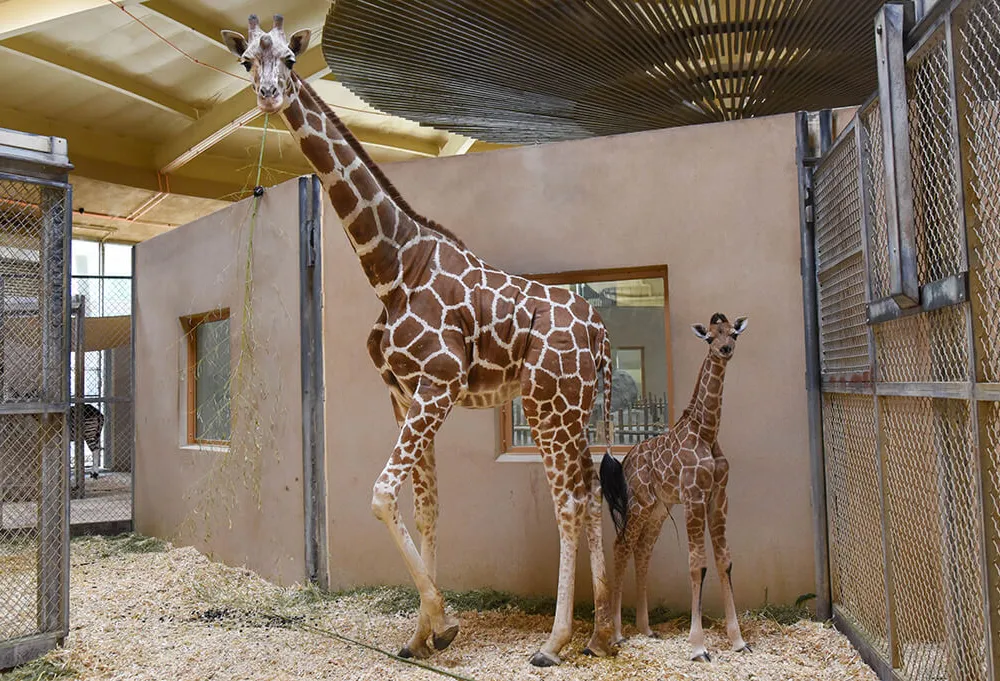No One Knew This Giraffe Was Pregnant—Until She Suddenly Gave Birth to a Healthy Baby Girl
No One Knew This Giraffe Was Pregnant—Until She Suddenly Gave Birth to a Healthy Baby Girl
Kipi, a 4-year-old reticulated giraffe and first-time mother, had only been at the Maryland Zoo for a few months when she surprised caretakers with her pregnancy
Kipi, the 4-year-old female reticulated giraffe, stands roughly 12 feet tall. Her calf is roughly 6 feet tall.
Maryland Zoo
Kipepeo was acting odd. On the night of March 26, caretakers at the Maryland Zoo noticed the 4-year-old reticulated giraffe wasn’t very interested in her food, and she seemed restless. They worried she might be sick, so they decided to keep an eye on her overnight.
At around 2 a.m. on March 27, they finally understood why Kipepeo’s behavior seemed off: She was going into labor.
That morning, Kipepeo, or “Kipi” for short, gave birth to a healthy baby girl that was a total surprise to her caretakers. Kipi had only been at the zoo for a few months, and her keepers had no idea she was pregnant.
“It was all pretty unexpected, but of course a very happy surprise,” says Margaret Innes, the Maryland Zoo’s general curator, to the Washington Post’s Dana Hedgpeth.
Kipi arrived at Maryland Zoo in late November from a facility in Texas that’s also accredited by the Association of Zoos and Aquariums (AZA). As she settled into her new home in Baltimore, she went through a standard quarantine behind the scenes and slowly got acquainted with the zoo’s two other giraffes. Kipi was officially introduced to the public in mid-January.
“Now we just need to let everybody know instead of having one new giraffe, we have two,” Innes tells the Baltimore Banner’s Clara Longo de Freitas.
The calf is nursing and doing well, according to the zoo. She and her mother are currently getting some bonding time, away from the public.
Maryland Zoo
Kipi, who stands roughly 12 feet tall, was named through a public contest. Kipepeo, pronounced key-PEH-pay-o, means “butterfly” in Swahili, according to the zoo.
Caretakers didn’t realize it at the time, but Kipi was pregnant long before she arrived in Baltimore. Reticulated giraffe pregnancies last for roughly 450 days, or around 15 months.
They had no reason to suspect she might be pregnant, however, as there was no record of Kipi breeding before she was transferred to the Maryland Zoo. At her previous zoo in Texas, she was kept with a herd of giraffes and likely mated with another member of the group when her caretakers weren’t looking.
Since they’re so large, giraffes tend to hide their pregnancies well. Often, the only way to tell a giraffe is pregnant is by testing for hormones in its feces.
“They’re such large-bodied animals with very long, large necks and fairly round bodies… so that when they’re carrying a much smaller animal inside, it’s not that noticeable,” Innes tells the Washington Post.Her calf—who will be named with help from the public—is nursing and doing well. Though she’s just two weeks old, the calf already weighs 128 pounds and stands around six feet tall.
“We’re keeping a close eye on the calf to make sure she hits her growth milestones, and so far, we like what we’re seeing,” says Erin Cantwell Grimm, the Maryland Zoo’s mammal curator, in a zoo statement.
Kipi, meanwhile, is being “a great first-time mother,” according to the zoo.
The Giraffe House is closed to the public for the foreseeable future to give Kipi and her calf some privacy and bonding time. The outdoor habitat, home to the zoo’s lone male giraffe, Caesar, is still open.
Soon, caretakers hope to introduce the calf to the zoo’s other adult female, a 14-year-old named Kesi who has been “really interested” in the new baby, Innes tells the Baltimore Banner. Kesi lives in the adjacent enclosure and keeps looking over at Kipi and her calf.
In the wild, reticulated giraffes (Giraffa camelopardalis reticulata) live in Ethiopia, Kenya and Somalia. Their name comes from the distinctive geometric patterns on their coats, which are unique to each individual.
An estimated 11,048 adults remain in existence, according to the International Union for Conservation of Nature (IUCN), but the population is declining because of habitat loss, poaching, drought and other issues. According to the nonprofit Giraffe Conservation Foundation, the subspecies has lost more than 50 percent of its population—down from an estimated 36,000 individuals 35 years ago.
Since their gestation period is so long and they only give birth to one calf at a time, the giraffes’ reproduction rate is struggling to keep pace with population declines. The IUCN has categorized reticulated giraffes as “endangered.”
Get the latest stories in your inbox every weekday.


